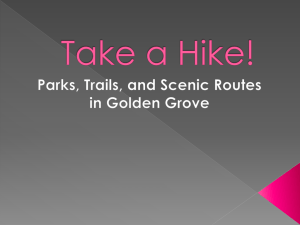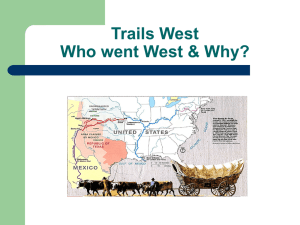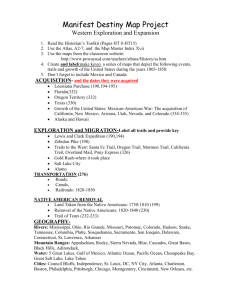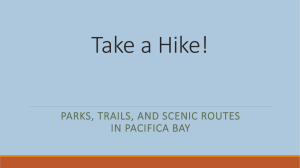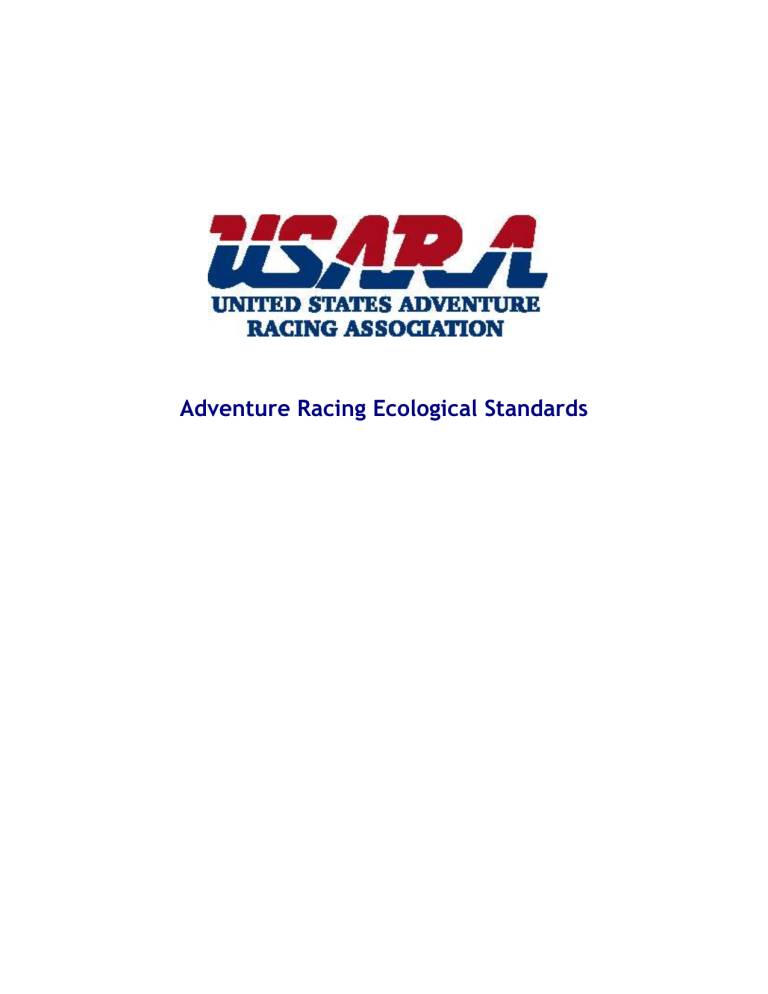
Adventure Racing Ecological Standards 1 USARA Ecological Standards Mission: To create an integrated set of ecological standards and suggested practices that support continued conservation and management of the outdoors. To promote environmental sustainability through a cooperative effort with Federal, State and Local governments and organizations. To educate adventure racing event promoters in proper sustainable outdoor ethics and practices when designing, developing and executing adventure races. The USARA Code of Ethics, Principles of Leave No Trace, and Tread Lightly! Pledge should be practiced at all times while enjoying the outdoors. A majority of the information contained in these USARA Ecological Standards is copyrighted by the Leave No Trace Center for Outdoor Ethics (the Center). Under special agreement with the Center, USARA has been granted permission to reprint this Leave No Trace information. For more information or to order materials, please visit http://www.LNT.org or call 1.800.332.4100. USARA Code of Ethics I will practice minimum impact traveling I will respect the land and inhabitants in which I travel I will not litter I will practice good sportsmanship I will lend aid to those in need during competition I will abide by the rules and regulations of the event Principles of Leave No Trace Plan Ahead and Prepare Travel and Camp on Durable Surfaces Dispose of Waste Properly Leave What You Find Minimize Campfire Impacts Respect Wildlife Be Considerate of Other Visitors Tread Lightly! Pledge Travel and recreate with minimum impact Respect the environment and the rights of others Educate yourself, plan and prepare before you go Allow for future use of the outdoors; leave it better than you found it Discover the rewards of responsible recreation 2 General Standards Be a goodwill ambassador for adventure racing. A friendly “Hi!” on the trail goes a long way. Know the regulations and special concerns for the area that you will visit. It is up to us to keep our outdoor environment healthy, beautiful and open for public recreation. Respect and be courteous to other visitors and protect the quality of their experience. Plan ahead. Prepare for your group activities by anticipating any possible problems or special concerns created by your event. Educate yourself. Know all rules, regulations and special concerns for any area that you visit. Check sustainability. Area land management agencies can suggest places and times suited to your group size and needs and free of known hazards. Choose appropriately. Adventure racing is not appropriate for designated Wilderness and other special areas. Check with area land managers before using sites to ensure the areas are appropriate for adventure races. Understand that area land managers do not have to allow an adventure race. Inform the public. Contact the local media and inform them of the event and the event activities after you have secured permission for the event. Prepare for the worst. When teams get lost or are in need of aid, there are implications for you, the people that are lost, the people who attempt to find them, and the environment. Significant impacts to the environment can result from rescue operations that involve vehicles or large numbers of people. Consider driving impacts. When driving to an area, drive only on open roads and park only in durable designated areas. Pack it in, pack it out. Do more than your share. Leave the area better than you found it. Practice the USARA Code of Ethics, Leave No Trace Principles, and The Tread Lightly! Pledge Hiking When selecting a hiking route, consider the challenges, beauty, and excitement the participant will experience. Plan the route with consideration for both present and future users, ensuring minimal impact. Selecting a Hiking Route Plan ahead and prepare for your group activities. Include in your planning any possible problems or special concerns created by your event. Before arriving at the trailhead take time to learn about the area in which you will be hiking. Check with area land management agencies and outdoor supply shops before hiking unfamiliar trails. Obtain a map of the area and determine which areas are open and suitable for your use. 3 Select a route and determine what special rules and regulations may be needed for that area. Coordinate selected hiking route with the area land management agencies. Leave a record of your plans. When possible hike only on durable surfaces such as trails, dirt roads, motorized trails, and pavement. Respect trail and road closures and restrictions. Instruct participants to walk single file in the middle of the trail even when wet or muddy to avoid widening the trail. Instruct participants not to short cut switchbacks (trail zigzags that ascend hill sides) Stay on existing trails, do not create new ones. Obtain all necessary permits or other authorization as may be required. Practice the USARA Code of Ethics, Leave No Trace Principles, and The Tread Lightly! Pledge When Traveling Off Trail with the Express Permission of the Area Land Management Agency Design the course and select routes that will allow participants to travel on durable surfaces. Rock, sand and gravel are the best; these surfaces are highly durable and can tolerate repeated trampling and scuffing. Ice and snow are acceptable surfaces; the effect of travel across these surfaces is temporary. The resistance of vegetation to trampling varies. Select areas of durable vegetation or areas with sparse vegetation so the vegetation is easily avoided. Dry grasses tend to be resistant to trampling. Wet meadows and other fragile vegetation quickly show the effects of trampling. Trampling ensures new travelers will take the same route, leading to further trampling. Avoid vegetation whenever possible, especially on steep slopes where effects of off-trail travel are magnified. Desert puddles and mud holes should be avoided at all cost, as they are precious resources for all living things in this environment. Instruct Participants in the Following Etiquette When Encountering Animals on the Trail Domestic Stock Groups leading livestock or on horseback have the right of way on trails. Move to the downhill side of the trail. It is easier for stock to see you and you appear as less of a threat. When passing horses use special care and follow directions from the horseback riders (ask if uncertain). Talk quietly to riders, so stock will recognize you as human and less of a threat. Never scare stock animals. Stock animals are startled by an unannounced approach, sudden movement or a loud noise. 4 Stick to the trail, this makes your movements predictable. Stock animals become accustomed to hikers on the trail. Give stock animals extra room and time to adjust to you. Wildlife Check with area land-management agencies to insure your event will not disturb wildlife brooding, nesting or other activities, and schedule your event accordingly. Stick to the trail, this makes your movements predictable. Wildlife becomes accustomed to hikers on the trail. If you encounter wildlife along the trail, the best response is to stop and allow the wildlife to depart on its own time. Back away if animals react to your presence. Avoid spooking range animals or wildlife. Slow down and keep your voices low. Proceed with caution. Mountain Biking A mountain bike’s speed, silence and maneuverability can pose problems on trails shared with hikers, equestrians and other mountain bikers. Mountain bikers must be careful to present a courteous and positive image when sharing the trail with others. The way we ride today shapes mountain bike trail access tomorrow. Do your part to preserve and enhance access and image by observing and following the Mountain Biking Standards. Selecting a Mountain Bike Route Plan ahead and prepare for your group activities. Anticipate any possible problems or special concerns created by your event. Before arriving at the trailhead take time to learn about the area in which you will be riding. Check with area land-management agencies and bike shops before riding unfamiliar trails. Make sure bikes are allowed on the trails you will be using. Obtain a map of the area and determine which areas are open and suitable for your use. Select a route and determine what special rules and regulations may be needed for that area. Coordinate selected biking route with the area land-management agencies. Leave a record of your plans. Only ride on durable surfaces such as trails, dirt roads, motorized trails, and pavement. Respect trail and road closures and restrictions. Stay on existing trails, do not create new ones. Obtain all necessary permits or other authorization as may be required. Practice the USARA Code of Ethics, Leave No Trace Principles, and The Tread Lightly! Pledge Instruct participants in the Following Mountain Bike Etiquette Respect other trail users. 5 Avoid trespassing on private land. Ride the center of the trail, do not widen the trail by riding the edges. Avoid skidding as it creates ruts in the trail and mars slick rock. Ride over water bars and downed trees; do not create new trails by riding around them. If you cannot ride over the obstacle, get off and walk your bike. Do not short-cut switchbacks (trail zigzags that ascend hillsides). Leave gates as you found them, or as marked. Pack it in, pack it out – do more than your share. Leave the area better than you found it. When Encountering Other Trail Users : Yield - Slow Down - Establish Communication - Be Prepared to Stop - Pass Safely Use proper etiquette when encountering stock animals or wildlife on the trail. Practice the USARA Code of Ethics, Leave No Trace Principles, and The Tread Lightly! Pledge Water Recreation Paddling offers us a chance to experience the outdoors from a different vantage point. Carefully select suitable launching and landing sites that will not suffer significant new impacts to vegetation, or result in soil erosion and add sediment to bodies of water. Selecting a Paddling Site Plan ahead and prepare for your group activities. Anticipate any possible problems or special concerns created by your event. Before arriving take time to learn about the bodies of water you will be using. Check with area land- and water-management agencies and paddling shops before entering unfamiliar waters. Get as much information about the boat traffic in the area as possible and plan your route accordingly. Obtain a map of the area and determine which areas are open and suitable for your use. Have nautical charts and topographic maps for the area you will be using. Nautical charts normally illustrate known hazards on the water (submerged rocks, currents). Topographic maps can help identify potential camping sites and emergency pullouts on land. Select a route and determine what special rules and regulations apply to that area. Make sure your watercraft is allowed on the bodies of water you will be using. Coordinate selected paddling route with the area land- and watermanagement agencies. Leave a record of your plans. Remember, poor planning and disregard for potential changes in weather can transform a simple paddle into a dangerous situation. Paddlers may be forced to land in sensitive areas causing lasting impacts on those areas. Determine whether the paddle launching and landing sites can sustain your group without suffering significant new impacts. Determine whether or not there are durable storage sites for the boats and gear to be stored. 6 Know Local, State, and Federal rules and regulations for the bodies of water you are using. Obtain all necessary permits or other authorization as may be required. Practice the USARA Code of Ethics, Leave No Trace Principles, and The Tread Lightly! Pledge Instruct Participants in the following Paddling Etiquette Stay on established trails at launching and landing sites. Many beaches have established trails leading to points on the water. Be considerate of waterfront property owners. Be considerate and efficient when launching or landing your watercraft. Respect the rights of others to enjoy the water. Honor all warning signs. Yield right-of-way to sailboats, commercial vessels, and fishing vessels. If you are forced off the water and into a sensitive area, search for durable surfaces for your shelter and boat storage. Leave aquatic plants and animals in the water. Pack it in, pack it out – do more than your share. Leave the area better than you found it. Practice the USARA Code of Ethics, Leave No Trace Principles, and The Tread Lightly! Pledge Ropes Ropes can add an exciting element to an adventure race. When designing a climb site be sure to protect the natural beauty for future visitors by ensuring the area will not suffer new impacts. Selecting a Climbing Site Plan ahead and prepare for your group activities. Anticipate any possible problems or special concerns created by your event. Before arriving at the climb site take time to learn about the area you will be using. Check with area land-management agencies and climbing shops before climbing in unfamiliar areas. Make sure climbing is allowed in the area you will be using. Obtain a map of the area and determine which areas are open and suitable for your use. Whenever possible, use an existing climb site. If you are considering developing new opportunities for climbing, consider whether the local ecology can withstand the increased traffic this new site will create. Consider variables such as rock type, typical forms of protection, vegetation, wildlife, and the use the area receives. Select a route and determine what special rules and regulations may be needed for that area. Coordinate selected climbing route with the area land management agencies. Use removable protection and natural protection whenever practical. 7 When using tree trunks as anchors, ensure their protection. Cleaning loose or friable rock from faces is sometimes necessary for safety. Avoid changing the rock to make the route easier or more comfortable. Remove all climbing gear (straps, hangers, pitons, nuts, etc.) from the climb site. Avoid nesting sites on or near the crags in the spring and early summer. Watch the birds as they circle and land near their nests to identify places to avoid. If you encounter nests on a climb, do not touch them. When traveling to the climbing site, stay on existing trails, do not create new ones. Obtain all necessary permits or other authorization as may be required. Practice the USARA Code of Ethics, Leave No Trace Principles, and The Tread Lightly! Pledge Camping Good campsites are found, not made. Protect the natural beauty for future visitors by ensuring the area will not suffer new impacts. Consider the following when selecting camping areas, transition areas and check points for your event. Selecting a Campsite Plan ahead and prepare for your group activities. Anticipate any possible problems or special concerns created by your event. Before arriving at the campsite take time to learn about the area. Check with area land-management agencies and outdoors shops before camping in unfamiliar areas. Obtain a map of the area and determine which areas are open and suitable for camping. Check wildfire danger ratings for that area, and the weather forecast. Select a campsite and determine what special rules and regulations may be needed. Coordinate selected campsites, transition areas and check points with the area land and water management agencies. Determine whether the site can sustain your group without suffering significant new impacts. Camp on durable surfaces. Select the most durable camping location possible. Camp on sites that are so highly impacted that further responsible use will cause no noticeable impact. Sand and gravel bars along large rivers or the ocean are durable surfaces suitable for appropriate camping. In pristine areas avoid repetitive traffic routes and move campsite every day to minimize the number of times a particular area of the site is trampled. Place tents in non-vegetated areas. Do not dig trenches around your tent or campsite. Avoid enlarging the area of disturbance. 8 Never scrape away or clean the site of organic matter such as leaves. The organic matter will help cushion trampling forces, limit the compactability of soils, release plant nutrients, and reduce the erosive effect of rainfall. Vary routes within your campsite so trails do not develop. Keep packs near you prior to bedtime to prevent extra trips. Campsite should be at least 200 feet from water. This allows access routes for wildlife and minimizes the impact to the water source. Wash yourself or dishes at least 200 feet away from water sources. Scatter strained dishwater. Avoid damaging plants or trees. Kitchens should be placed on durable surfaces such as rock, sand or gravel. Practice the USARA Code of Ethics, Leave No Trace Principles, and The Tread Lightly! Pledge Breaking camp Take time to naturalize the site. Cover scuffed areas with native materials such as pine needles or leaves. Brush out footprints and rake grassy areas with a stick to help the site recover and make it less obvious as a campsite. Pack it in, pack it out – do more than your share. Leave the area better than you found it. These extra efforts will help hide any indication where you camped and make it less likely that other back-country travelers will camp in the same location Minimal Impact Campfires Before Building a Campfire Ask the Following Questions: Do you need a campfire? Are campfires allowed in the area? (Check with area land management agencies.) What is the fire danger for this time of year and the location you have selected? Is a fire safe? (Judge the wind and direction.) Are there restrictions or fire bans in place? Is there sufficient dead wood on the ground so its removal will not be noticeable? Does the harshness of alpine and desert growing conditions for trees and shrubs mean that the regeneration of wood sources cannot keep pace with the demand for firewood? Campfire Standards If necessary provide required equipment, such as a camp stove for cooking, in place of a campfire. Camp in areas where wood is abundant or bring your own firewood. The best place to build a fire is within an existing fire site. Do not make a fire ring around the campfire out of rocks. This only scars the rocks and gives a false sense of containing the fire. Standing trees, dead or alive are home to many animals so leave them alone. 9 Fallen trees also provide animal shelter, increase water-holding capacity of soil, and recycle nutrients back into the environment so it is best to leave them alone. Dead and downed wood burns easily, and leaves less impact. Use small pieces of wood no larger than the diameter of an adult wrist that can be broken with your hands. Gather wood over a wide area away from camp. Use driftwood on rivers, lakes or seashores. Keep the fire small and burning only for the time you are using it. Allow wood to burn completely to a white ash. Put out fires with water, not dirt. Dirt may not completely extinguish the fire. Avoid building fires next to rock outcrops where the black scars will remain for many years. Scatter ashes over a large area away from the camp. Scatter unused wood to keep the area natural looking. Pack out campfire litter (plastic and foil items should never be burned). Pack it in, pack it out – do more than your share. Leave the area better than you found it. Practice the USARA Code of Ethics, Leave No Trace Principles, and The Tread Lightly! Pledge Waste Disposal Determine any waste disposal problems that will be created by your event. Develop solutions to these problems using the following standards. Waste Disposal Standards Check with area land-management agencies for rules and regulations of waste disposal for the areas you will be utilizing. Ask area land-management agencies if waste can be disposed in catholes or if waste must be packed out. Instruct Participants in the Required Method of Proper Waste Disposal Pack it in, pack it out – do more than your share. Leave the site better than you found it. Whenever possible, take time to locate and use bathrooms, outhouses, and other developed sites for human waste disposal. Provide extra portable toilets to support your event. In areas without toilets, bury your waste. Human waste should be buried in a shallow hole (6”-8” deep) at least 200 feet from water sources, camp sites or trails. Cover and disguise hole with natural materials. Use toilet paper sparingly. Dispose of toilet paper in the hole or pack it out. An alternative to burying waste is to have participants pack it out. Provide biodegradable waste bags for participants to pack out waste. Always pack out feminine hygiene products because they decompose slowly and attract animals. Urine has little direct effect on vegetation or soil. In some instances urine may draw wildlife, which are attracted to the salts. This wildlife can defoliate plants and dig up soil. Urinating on rocks, pine needles, and gravel is less likely 10 to attract wildlife. Diluting urine with water can help minimize negative effects. Special considerations for river canyons: River canyons present a unique problem. The most common practice is to urinate directly in the river and pack out feces in sealed boxes for later disposal. Special considerations for caves: All human waste, both solid and liquid, must be packed out. Practice the USARA Code of Ethics, Leave No Trace Principles, and The Tread Lightly! Pledge 11 United States Adventure Racing Association Our mission is to guide and assist race directors and committees in conducting fun, safe, and fair events. To provide for the health, welfare, and safety of participants, spectators, officials and volunteers. To aid in the continued positive growth of the sport of adventure racing. www.usara.com Leave No Trace The Leave No Trace Center for Outdoor Ethics is a national non-profit organization dedicated to promoting and inspiring responsible outdoor recreation through education, research and partnerships. Leave No Trace builds awareness, appreciation and respect for our wild lands. www.lnt.org Tread Lightly! Tread Lightly! is an educational program dedicated to increasing awareness of how to enjoy the great outdoors with responsible use while minimizing impacts. www.treadlightly.org The Nature Conservancy To preserve the plants, animals and natural communities that represent the diversity of life on Earth by protecting the lands and waters they need to survive. www.tnc.org International Mountain Bicycling Association IMBA creates, enhances and preserves trail opportunities for mountain bikers worldwide. Since 1988, IMBA has been bringing out the best in mountain biking by encouraging low-impact riding, volunteer trailwork participation, cooperation among different trail user groups, and innovative trail management solutions. www.imba.com Adventure Racers For The Environment Adventure Racers for the Environment was developed to encourage environmental education and service projects by adventure racers. www.arfe.org American Recreation Coalition Dedicated to the protection and enhancement of everyone’s right to health and happiness through recreation. www.funoutdoors.com 12 National Park Service The National Park Service preserves unimpaired the natural and cultural resources and values of the National Park System for the enjoyment, education, and inspiration of this and future generations. www.nps.gov Bureau of Land Management The mission of the Bureau of Land Management (BLM) is to sustain the health, diversity and productivity of the public lands for use and enjoyment of present and future generations. www.blm.com U.S.D.A. Forest Service The mission of the U.S.D.A. Forest Service is to achieve quality land management under the sustained multiple-use management concept to meet the diverse needs of the people. www.fs.fed.us U.S. Fish and Wildlife Service The mission of the U.S. Fish and Wildlife Service, working with others, is to conserve, protect and enhance fish and wildlife and their habitats for the continuing benefit of the American people. www.fws.gov U.S. Army Corps of Engineers The Army Corps of Engineers is a steward of land and water, on Corps water resource projects. The Army Corps of Engineers Natural Resources Management Mission is to manage and conserve natural resources, consistent with ecosystem management principles, while providing quality public outdoor recreation experiences, to serve the needs of present and future generations. www.usace.army.mil 13 Acknowledgements The following provided a coordinated effort in the development of the United States Adventure Racing Association Ecological Standards. Thank you for sharing your knowledge, patience and efforts in providing the valuable information in this manual. Susy Levin, Leave No Trace – LNT Ben Lawhon, Leave No Trace – LNT Troy Farrar, United States Adventure Racing Association – USARA Jill Scott, Tread Lightly! – TL! Emily Whitted, The Nature Conservancy - TNC Dan Vardamis, International Mountain Bicycling Association - IMBA Yi Shun Lai, Adventure Racers For The Environment – ARFE Matthew Evans, Adventure Racers For The Environment – ARFE Derrick Crandell, American Recreation Coalition - ARC Joel Frank, National Park Service – NPS Lee Larson, Bureau of Land Management – BLM Jim Miller, U.S.D.A. Forest Service – USDA-FS Jamie Schwartz, U.S.D.A. Forest Service – USDA-FS Don Fisher, U.S.D.A. Forest Service – USDA-FS Nancy Gloman, U.S. Fish & Wildlife Service - USFWS Larry Bogue, U.S. Army Corps of Engineers - USACE
